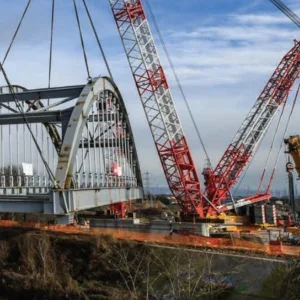Loader crane manufacturers have traditionally used hydraulic piston pumps as the heart of their power control system. This is due to their high pressure capability which gives a compact power source. Indeed, the power density of these piston pumps has been unsurpassed for years.
But today, improved designs have led to an alternative source of power which is quieter, cheaper and offers superior versatility to the loader crane designer.
Vane pump technology has now been developed so far in terms of pressure performance, to make it a prime choice for a wide range of mobile applications.
In this area, the hydraulic vane pump is scoring points as the preferred fixed displacement pump by many vehicle designers, and here we explain the evolution of the vane unit into what is probably the most versatile hydraulic pump in existence today.
Crane system design
Typical truck loader cranes are powered by a piston pump of bent axis design, which works at normal duty pressures from 250 bar to 300 bar, sometimes up to 340 bar.
Denison vane pumps, for example, reach pressures of 320 bar, and are capable of producing a peak pressure of 400 bar, which easily makes them capable of satisfying the pressure demands of this application. Similar pump mountings can also be offered, whereby the pumps are typically close coupled to the truck’s PTO unit.
Some loader crane systems use a double piston pump which offers one flow for lifting, and one for the slow control. Here, piston pumps in particular, do not lend themselves to offering various flow options from one body type. Vane pumps on the other hand, due to their inherent design, can offer a multitude of flow options from the same basic pump body, whereby the loader crane designer can choose the best flow combination to optimise loader performance.
Vane pump design
The basic design of a vane pump consists of a slotted rotor, which houses sliding vanes which are held out against an external cam ring by springs, pressure or both. End faces are sealed by a port plate and as the rotor turns, the varying volume of oil trapped between adjacent vanes results in a pumping action.
In some conventional vane pumps, the vanes are spring-loaded to maintain vane contact with the cam ring. The disadvantage here is that the spring applies a constant load against the ring, with no relation to pump discharge pressure, resulting in continuous wear proportional to spring force.
Instead of the spring, a better Denison design uses a pressure fed round pin under each vane, to load it against the cam ring. Loading is then in direct proportion to pump discharge pressure, which minimises wear and prevents overshoot-pressure or vane blow-off.
This means that pumps can operate at lower pressures and speeds than the spring designs, and, the pin dimensions can easily be altered to suit the designed speed range or pressure range. This is important for mobile applications, where pumps can be designed to perform at optimum levels, at the specified speed ranges.
Double lip vanes instead of single lip, patented by Denison Hydraulics, have been shown to improve both tolerance to contamination and operating life, and when combined with a special dry lubricant coating the cam rings, these design enhancements really show benefits.
Cam rings are usually oval in shape, so providing two pumping actions per revolution, which also maintains the unit in ‘balance’, ultimately resulting in improved bearing life. Overall efficiency can be 93% and double or triple units are also available with one suction port.
Unlike gear pump or piston pump designs, the vane design has the added advantage that various displacement sizes are available from one basic body size, after a simple change of the cam ring. This is an important feature for loader crane designers, who can standardise on one envelope size for a range of flow requirements.
Advantages of vane technology
Legislation on noise, particularly on mobile plant, means that vehicle designers face a constant challenge in adding baffles and cladding to vehicles to stay within the limits. But today engineers are turning to vane pump technology to give a quieter system.
It is a design fact that vane unit efficiency is not quite as high as piston unit efficiency. Typically the figures are 93% compared to 96% overall efficiency. This is not a problem with the new low duty cycle of the mobile loader crane.
The simplicity of the vane technology compared to piston means that the unit cost of a vane pump is lower. Add to this the advantage of lower noise, and it means that a vane pump can be a substantially cheaper alternative when the added cost of noise suppression is taken out.
Versatility is another advantage. A simple change of cam ring changes the vane unit’s flow output. Typically there are 13 different flow options from a single pump body, or nearly 100 different combinations in a double pump with the same size body. Here, loader crane designers can standardise on one pump body size and the associated flange connections for their complete range of cranes, and call up the optimum flow combination for each particular model.
One loader manufacturer, Rotobec in Canada, has already benefited from Denison vane pumps, where the cartridge approach to service and repair greatly simplifies field maintenance. They also found that modern vane pumps tolerate a much wider range of fluid viscosities than anyone would have thought possible just a few years ago. Denison’s T6 series, for example, can operate effectively with fluid viscosities ranging from 60 SUS to 9240 SUS. This means Rotobec customers can start using their loaders quicker in cold weather because a minimum warm up time is required, and they can run them hotter in the summer without a loss of efficency or causing excess wear.
Due to ever increasing demands for hydraulics to be environmentally friendly, and after exhaustive testing, Denison Hydraulics can confidently claim that using biodegradable fluids with these units is not a problem – some vane pumps actually perform better on these oils.
What was once thought of as the humble vane pump, can now be seen as a most versatile and efficient unit, finding a foothold as the prime choice of power source on much mobile machinery. Many manufacturers of earthmoving and construction machines have turned to vane pumps to take advantage of their all-round lower noise, better resistance to contamination, versatility, cost effectiveness and efficiency, and it should not be too long before loader crane manufacturers also start to realise these benefits.






